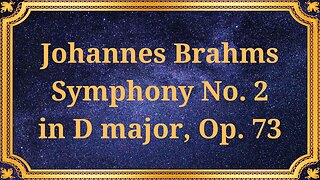Premium Only Content

Beethoven Piano Sonata No.25 in G major, Op.79
#Beethoven #sonata_for-piano #classical_music
Beethoven Piano Sonata No. 25 in G major, Op.79 stands as a testament to Ludwig van Beethoven's genius and his immense contribution to the world of classical music. This sublime composition showcases Beethoven's mastery in crafting intricate melodies and harmonies that have captivated audiences for centuries.
Beethoven composed Piano Sonata No. 25 in G major, Op.79 during the early 1800s, a period marked by his transition from the classical style of Mozart and Haydn to his distinctive and innovative musical language. This sonata belongs to Beethoven's middle period, where his compositions began to display greater complexity and emotional depth, setting the stage for his later groundbreaking works.
Op.79 comprises three movements, each with its own unique character and musical elements:
a. Movement 1 - Presto alla tedesca:
The first movement presents a lively and spirited atmosphere. Its brisk tempo, rhythmic drive, and playful motifs create a joyful and energetic mood. Beethoven employs frequent syncopations and sudden dynamic shifts, adding a sense of unpredictability to the composition.
b. Movement 2 - Andante:
The second movement contrasts the first with a more serene and introspective character. Beethoven unfolds a lyrical melody, evoking a contemplative ambiance. The piece showcases his skill in crafting beautiful and expressive melodies, enhanced by delicate harmonies and subtle variations.
c. Movement 3 - Vivace:
The final movement returns to a lively and spirited tempo. This joyful and exuberant conclusion rekindles the energy of the first movement, featuring intricate and virtuosic passages that demonstrate Beethoven's technical prowess. The piece culminates in a thrilling finale, leaving a lasting impression on the listener.
Beethoven's mastery of harmony is evident throughout the sonata. He incorporates unexpected and daring harmonic progressions, challenging traditional tonal boundaries and expanding the expressive possibilities of the music.
Beethoven's deliberate use of sudden dynamic contrasts heightens the emotional impact of the composition. The juxtaposition of soft and gentle passages with powerful and thunderous sections adds depth and drama to the overall musical experience.
Beethoven's meticulous attention to articulation markings, such as staccato, legato, and accents, further enhances the interpretative possibilities of the piece. These nuances allow performers to imbue the music with their own unique expression and convey the intended emotions.
Beethoven's Piano Sonata No. 25 in G major, Op.79 has left an indelible mark on the classical music repertoire. Its innovative harmonic language and expressive qualities have inspired generations of composers and performers, influencing subsequent musical developments. The sonata's enduring popularity is a testament to Beethoven's profound impact on the evolution of Western classical music.
Beethoven Piano Sonata No. 25 in G major, Op.79 is a masterpiece that showcases the artistic brilliance and creative genius of Ludwig van Beethoven. Its historical significance, intricate musical structure, and notable features contribute to its timeless allure. As this iconic composition continues to resonate with audiences around the world, it serves as a testament to Beethoven's enduring legacy and his status as one of the greatest composers in history.
-
 36:10
36:10
Classical music_Music Inspiration
1 month agoJohannes Brahms Symphony No. 2 in D major, Op. 73
671 -
 LIVE
LIVE
Russell Brand
3 hours agoWatch With Us: Tommy Robinson – Silenced (Part 2) - SF608
1,139 watching -
 LIVE
LIVE
StoneMountain64
2 hours agoBest META for my 1st solo win
245 watching -
 2:55:45
2:55:45
Tucker Carlson
1 hour agoScott Horton: Coups, WMDs, & CIA – A Deep Dive Into What Led to the US/Israeli War With Iran
4.25K1 -
 LIVE
LIVE
Side Scrollers Podcast
3 hours agoSTOP KILLING GAMES CRUSHES GOAL + OUR FINAL SHOW BEFORE SUMMER BREAK | Side Scrollers Live
283 watching -
 2:58:28
2:58:28
Due Dissidence
5 hours agoTrump Bill ADVANCES To House Floor, MIXED Diddy Verdict, Natives PROTEST Alligator Alcatraz
3.12K8 -
 36:47
36:47
Members Club Pod
21 hours ago $0.78 earnedEpisode 1 – Welcome to the Club
12.3K4 -
 10:34
10:34
Bearing
7 hours agoShe's Trying to CENSOR the Internet .. but she's LOSING 🤣 Billboard Chris vs Thought Police 💥
2.38K14 -
 32:43
32:43
The Jack Brewer Show
20 hours agoThe Jack Brewer Podcast S1 EP1 | Congressman Burgess Owens on Fatherhood, Faith & America First
822 -
 24:23
24:23
The Boomer Effect
23 hours agoWhat Drives Homicide Trends?
4391